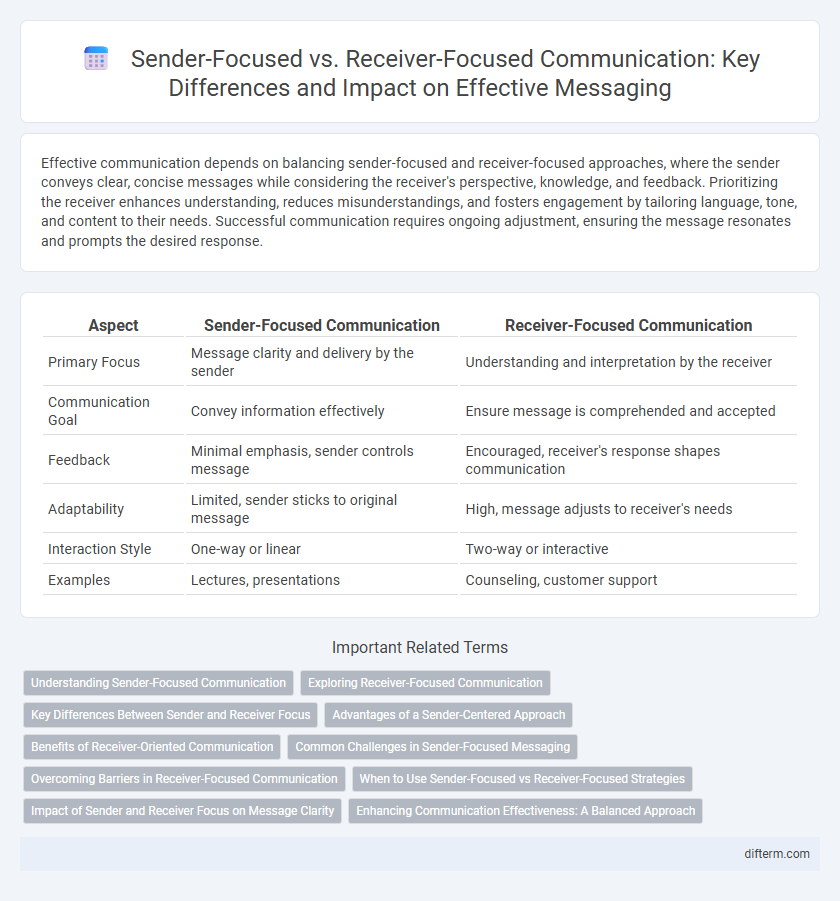Effective communication depends on balancing sender-focused and receiver-focused approaches, where the sender conveys clear, concise messages while considering the receiver's perspective, knowledge, and feedback. Prioritizing the receiver enhances understanding, reduces misunderstandings, and fosters engagement by tailoring language, tone, and content to their needs. Successful communication requires ongoing adjustment, ensuring the message resonates and prompts the desired response.
Table of Comparison
| Aspect | Sender-Focused Communication | Receiver-Focused Communication |
|---|---|---|
| Primary Focus | Message clarity and delivery by the sender | Understanding and interpretation by the receiver |
| Communication Goal | Convey information effectively | Ensure message is comprehended and accepted |
| Feedback | Minimal emphasis, sender controls message | Encouraged, receiver's response shapes communication |
| Adaptability | Limited, sender sticks to original message | High, message adjusts to receiver's needs |
| Interaction Style | One-way or linear | Two-way or interactive |
| Examples | Lectures, presentations | Counseling, customer support |
Understanding Sender-Focused Communication
Sender-focused communication centers on the message originator's intentions, emotions, and clarity, aiming to convey information precisely as intended. This approach emphasizes the sender's responsibility to encode messages clearly and choose appropriate channels to minimize misunderstandings. Effective sender-focused communication requires careful consideration of language, tone, and context to ensure the message is perceived accurately by the receiver.
Exploring Receiver-Focused Communication
Receiver-focused communication prioritizes understanding the audience's needs, emotions, and context to tailor messages effectively and enhance clarity. It employs active listening, empathy, and feedback mechanisms to ensure the receiver accurately interprets the intended message. This approach improves engagement, reduces misunderstandings, and fosters stronger interpersonal connections.
Key Differences Between Sender and Receiver Focus
Sender-focused communication emphasizes clear message articulation, ensuring the sender's intent and information are precisely conveyed. Receiver-focused communication prioritizes understanding and interpreting messages according to the receiver's context, cognitive framework, and feedback. Key differences include control over message content, with sender-focus driving structure and clarity, while receiver-focus enhances comprehension and engagement through active listening and adaptation.
Advantages of a Sender-Centered Approach
A sender-centered approach in communication ensures clarity and precision by allowing the sender to fully articulate their intent and key messages without immediate modification. This method aids in establishing a strong, consistent voice and reduces the risk of message dilution or misinterpretation early in the communication process. Emphasizing sender control also facilitates efficient information delivery, which is crucial in environments demanding quick and decisive exchanges.
Benefits of Receiver-Oriented Communication
Receiver-oriented communication enhances message clarity by tailoring content to the audience's needs and comprehension levels, reducing misunderstandings. It fosters stronger relationships and trust as the sender actively considers the receiver's perspective and feedback. This approach improves overall engagement and effectiveness in both personal and professional interactions by prioritizing the receiver's experience.
Common Challenges in Sender-Focused Messaging
Sender-focused messaging often leads to miscommunication due to the lack of audience consideration, resulting in unclear or irrelevant content delivery. This approach can cause the receiver to disengage, as the message may not address their needs or context, reducing its overall effectiveness. Frequent challenges include message overload, inappropriate tone, and insufficient feedback mechanisms that hinder understanding and mutual connection.
Overcoming Barriers in Receiver-Focused Communication
Overcoming barriers in receiver-focused communication requires prioritizing the audience's perspective and actively interpreting their feedback to ensure message clarity. Techniques such as empathetic listening and tailored content help break down misunderstandings caused by cultural differences, language barriers, or emotional distractions. Emphasizing receiver comprehension enhances engagement, minimizes miscommunication, and drives effective information exchange.
When to Use Sender-Focused vs Receiver-Focused Strategies
Sender-focused strategies excel when clarity, authority, and control over message content are crucial, such as in formal announcements or instructional communication. Receiver-focused strategies are vital in situations requiring empathy, active listening, or feedback integration, enhancing understanding and engagement in interpersonal or customer service interactions. Choosing between these approaches depends on the communication goal, audience needs, and context sensitivity to optimize message effectiveness.
Impact of Sender and Receiver Focus on Message Clarity
Sender-focused communication emphasizes clear articulation and structured message delivery to minimize ambiguity, enhancing the sender's ability to convey precise information. Receiver-focused communication prioritizes understanding the audience's perspective, adjusting language and tone to improve message comprehension and engagement. Balancing sender clarity with receiver awareness significantly elevates overall message effectiveness and reduces miscommunication.
Enhancing Communication Effectiveness: A Balanced Approach
Enhancing communication effectiveness requires balancing sender-focused clarity with receiver-focused empathy. Clear messaging from the sender ensures information accuracy, while attentiveness to the receiver's perspective improves understanding and engagement. Integrating both approaches fosters meaningful dialogue and reduces miscommunication.
sender-focused vs receiver-focused Infographic

 difterm.com
difterm.com